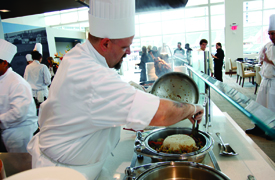Stadium foodservice operators leverage a variety of equipment to execute diverse menus out in front of the watchful eyes of their customers.
Stadium foodservice menus have become far more diverse than the traditional hotdogs, popcorn, nachos and soft drinks. Today's more discriminating fans can choose from a variety of dining options while cheering on their favorite team or performer.
 "In the late '80s and early '90s, typical concession stands with basic offerings like hot dogs and pretzels made up about 80 percent to 90 percent of the menu, while the remaining outlets had a grill and fryer to prepare burgers, fries and basic deli sandwiches," says Eric Wooden, vice president of facility design at Centerplate, a Stamford, Conn.-based hospitality company that provides foodservice for stadiums and other venues. "The offerings and guest expectations were very basic."
"In the late '80s and early '90s, typical concession stands with basic offerings like hot dogs and pretzels made up about 80 percent to 90 percent of the menu, while the remaining outlets had a grill and fryer to prepare burgers, fries and basic deli sandwiches," says Eric Wooden, vice president of facility design at Centerplate, a Stamford, Conn.-based hospitality company that provides foodservice for stadiums and other venues. "The offerings and guest expectations were very basic."Over the last decade, foodservice at these locations has turned into one of the most important aspects of the event. "Food is the way fans connect to the building, team or event, and brand," Wooden says.
Stadium foodservice now encompasses not only concessions operations, but also full-service restaurants; club level options, which can include all-inclusive or pay-as-you-go buffets; catering; and in-seat service.
The foodservice contractor-run recreation segment, which includes stadium foodservice, is estimated to be a $5.2 billion industry in terms of revenue, according to Technomic, a Chicago-based research firm. U.S. Census data indicates that food and alcohol revenue at self-op spectator sports establishments totaled approximately $930 million in 2007, the last year for which this information is available.
More concessions operations now accomplish about half the cooking at each location in the stadium. Previously, much of the cooking took place off site or in a production kitchen. As a result, combi ovens and induction cooking units in both carts and permanent stands are being utilized. Other trends in this segment include utilizing locally grown ingredients and an increase in ethnic food offerings.
"Today, fans want to see where the product is coming from," Wooden says. "Passing food through a window doesn't cut it anymore."
What makes the stadium foodservice segment unique is the daily volume and scale. "Feeding as many as 80,000 people at a single event or game means speed of service, managing throughput and keeping fresh product in-house are key," Wooden says.
- Combi ovens
- Fryers
- Flat top griddles
- Induction burners
- Reach ins
- Roller grills
- Three compartment sinks
- Retractable heat lamps
- Transportability: Equipment used in concessions operations is typically moved around often to different stands and/or areas throughout the season. Casters and quick disconnect options help facilitate relocation.
- Reliability and Durability: Stadium foodservice operations are geared for high volume in short periods of time. Durable units that provide quick recovery times are needed to stand up to the heavy usage.
- Flexibility: Stadium menus change, depending on the event and its attendees. Equipment should accommodate a variety of production needs and food types.




